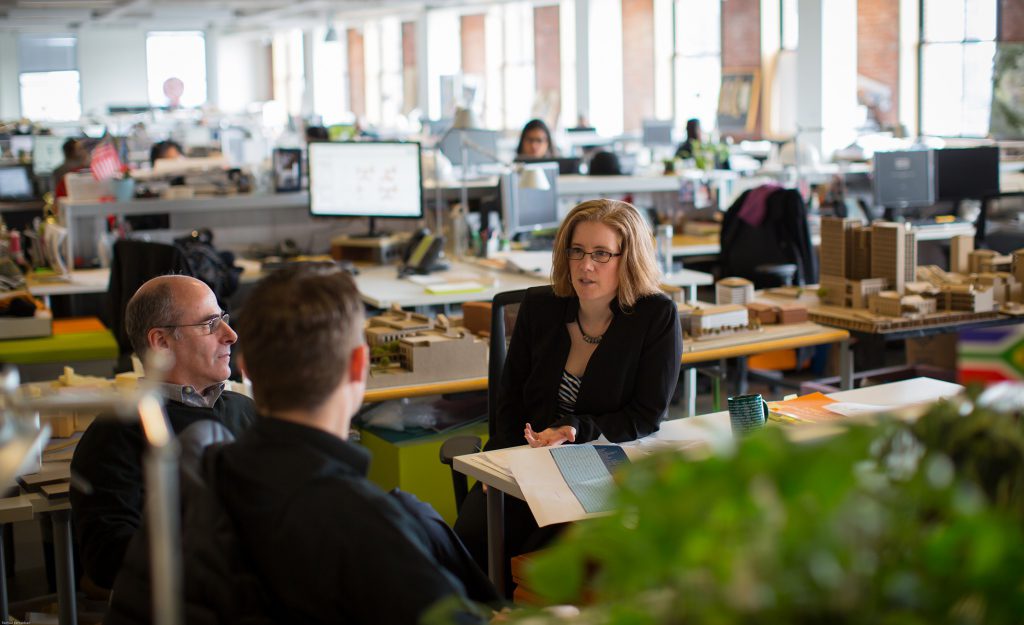Sarah Lindenfeld joined PAYETTE in 2014. She has over 15 years of experience in architecture and design, both domestically and internationally. Her project experience ranges from academic science buildings to performing arts centers and libraries.
Sarah worked on the Skidmore College Center for Integrated Sciences, as well as the Master Space Plan for the College of Natural Sciences and the Welch Hall Renovation, each for the University of Texas at Austin. She was also the Project Architect for the renovation and expansion to the University of Alabama at Birmingham School of Nursing.
Sarah has been an active participant in the Women in Design Committee at the Boston Society of Architects, including serving on the Mentoring Sub-Committee and Steering Committee. She currently sits on the BSA Honors and Awards Committee.
Here, Sarah shares a bit about herself.

Please describe your career and path to leadership?
My first job in architecture was as a receptionist at Safdie Architects. I always describe it as the best interview I almost didn’t go to, because it led to nearly 20 years of association with the firm. That first job enabled me to learn about the process from the ground up. When I started graduate school the next year, I was already ahead of my classmates in that I knew how an architecture firm operated, and had a good sense of how many different skill sets went into realizing successful buildings. I worked at Safdie as a summer intern during grad school and made sure that they knew when I would finish my thesis, and I later came back as a full-time designer.
On my first day as a full-time designer, I was lucky enough to be assigned to work on the Kauffman Center for the Performing Arts (KCPA). This project would occupy me for the next ten years. It was a fantastic way to learn from the ground up, and by the time we were in CDs and CA, I was managing the project. It was an incredible experience to manage a project that I knew so intimately, and it cemented my love of project management. I was fortunate to have a wonderful mentor, Isaac Franco, who was also the Principal on the Kauffman Center project. We worked together on the KCPA and a few other projects for the entire time I was at Safdie, and I still meet with him regularly.
When I came to PAYETTE in 2014, I knew almost immediately that I had found a new professional home base. The firm was welcoming and more than willing to work with me to learn new project typologies while taking advantage of my existing skills. I’ve been able to add practice management to my portfolio, and now as Managing Principal, I look forward to growing further in this new role.
What does being a leader mean to you?
Much of being a leader is about enabling all the people around you to do great things and work to the best of their potential. I have always worked on projects that were large and complex, so trust between team members is critical. Once I get to know a team member’s capabilities, strengths and areas for improvement, I try to give them enough leeway and freedom so that they can learn on their own, while making it clear that I am always available for questions.
What’s the best advice you’ve received?
Keep the headphones off – listen and learn to what is going on around you. I ended up sitting next to a Principal from almost my first day at Safdie, and the amount of knowledge I picked up by overhearing conversations about my project and other projects in the office was immensely helpful. Sitting next to someone more senior than you is an opportunity to learn about project issues and considerations that you may not otherwise hear of.
What advice would you give to emerging female designers?
- Promotion and professional growth are not just about taking the exam, although that is a crucial step. Find your passion outside of project work and pursue it, whether it is joining and becoming a vital member of an existing committee or group, starting a new group, getting involved in the BSA, or giving back through another architecture-related organization in the community.
- Take a (literal) seat at the table.
- Learn and then practice self-awareness in your professional life. Learn and understand what inspires you and what you are good at, then pursue those things, be proud of them, and be vocal about them. When you show that you understand your strengths and weaknesses, others see that and are more likely to come to you as a resource.

